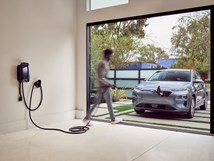Plastics Role in Future Car Designs
DuPont engineering survey highlights some of the latest issues and developments.

A material based on recycled materials that can be used for Class A surface components.
Earlier this year, a study was conducted by DuPont Company (automotive.dupont.com) and the Society of Automotive Engineers (SAE) among a group of more than 500 SAE members, design engineers, half employed by OEMs and the other half employed by suppliers. What is interesting to note is that materials, while not at the top of the list of things that automakers are considering to meet forthcoming fuel-efficiency regulations, are certainly key, especially when considered from a more holistic point of view.
That is, the results show that in order to meet the emerging regulations they’ll do it through:
• 61%—engine downsizing with power-boost technology
• 51%—hybrid and electric powertrains
• 32%—downsizing vehicles
• 28%—lightweight structural materials
• 13%—fuel cells
While DuPont Automotive is certainly interested in the lightweight structural materials category—after all, they are a leading supplier of polymer-based materials—David Glasscock, Ph.D., DuPont global automotive technology director, noted that engine downsizing with power-boost technology (e.g., turobocharging) generally means higher temperatures, and pressures, so this actually fits into an area where DuPont plays, like using its Nomex brand fiber used to protect hoses in the turbocharger.
Material Success
But a couple other survey results indicate that polymer-based materials technology is considered to be important to design engineers going forward. Asked “How Important Are Materials to a Product’s Success?”, 79% believe that in 10 years’ time, materials will be “Very Important.” And of the top three “Materials Poised for Growth,” resins play a role: 75% Advanced Composites, 56% Plastics, 50% Aluminum. (One could argue that first category could consist of metal-matrix composites, most of the composites used in automotive applications are generally fiber in a resin matrix.)
Glasscock: “As fuel economy and emissions regulations challenge the design of practically every vehicle system, materials have become integral to design.” Now and certainly going forward.

Results from a DuPont/SAE study conducted by Signet Research.
Class A Green
While there is an ever-increasing number of applications for recycled plastics in auto applications, often these are for non-visible or non-cosmetic applications. But Bayer MaterialScience (bayermaterialscience.com) has introduced a blend of polycarbonate and polyethylene terephthalate (PC + PET) that can be used in place of steel, aluminum, and sheet molded compound (SMC) in horizontal body panel applications. Because it offers low, largely isotropic thermal linear expansion so there can be tight gaps between adjacent components. There is low density so there is a potential weight-save.
That’s right: a recyclate that results in Class A surfaces. Applications for Makroblend GR 235M include spoilers, trunk lids, and convertible top tonneau covers.
The PET is sourced from beverage bottles. The polycarbonate was developed for commercial five-gallon water bottles.
According to Dr. Eckhard Wenz of Bayer MaterialScience, “By using the blend, which conserves energy and raw materials, our customers in this industry can operate much more sustainably without having to accept the compromises regarding material properties associated with most other recyclates.”
____________
Sitting Lighter
One of the areas in vehicle interiors that has long been metal-centric is seat frames. Sure, there is plenty of foam and fabric involved, but when you get below all that there is almost invariably the metal part of the structure within.
So it is interesting to note that Faurecia (faurecia.com), a seating supplier (among other automotive components) and Rhodia (rhodia.com), a chemical company, have announced a collaborative effort to produce lightweight structural seat components with polyamide-based high-performance engineering plastics.
The companies are working toward using a Rhodia impact-modified polyamide for seat cushion structural components that will be 20% lighter than steel parts and still meet safety requirements.
Series production is anticipated in 2014.
Fit for Royalty
While it wasn’t The Royal Wedding, in July, His Serene Highness Prince Albert II of Monaco was wed to Ms. Charlene Wittstock.
Which we point out only because of the “official Royal Wedding car,” a Lexus 600h L hybrid that was converted by Belgian coachbuilders Cara Duchatelet with assistance from Lexus engineers. The notable part of the conversion was turning the sedan into a Landaulet, in this case using a one-piece, transparent polycarbonate roof over the rear seat rather than putting a convertible top over that section, as is the usual case with a Landaulet configuration.
Because the roof is a key component of a unibody structure, the engineers had to determine how to strengthen the car without adding too much mass: this is a hybrid that can run on electric power alone, so a goal is to keep it comparatively light.
They performed extensive computer-aided analysis on the way to creating Kevlar and carbon-fiber components to maintain the vehicle’s chassis stiffness and torsional rigidity even though the C-pillars and half the roof area were eliminated.
The car was largely disassembled so that the composite components could be cured right onto the bare chassis in a specially built oven.
The polycarbonate roof is 8-mm thick and weighs 26-kg. A challenge—beyond just making the piece—was assuring that it would fit onto the body structure. So a template was produced with composite to validate the shape, structural integrity and fit of the roof-to-body. The tolerances were less than 1-mm. The final canopy machining was performed with robotic tools.
It took a team of craftsmen and engineers two weeks to reassemble and finish the Midnight Blue car for the royal nuptials.

This Lexus LS 600h L had a special polycarbonate roof created for it as it was the official car of the royal wedding in Monaco.
Modular in China
The first Chinese-developed car with an all-plastic front-end module (FEM) was rolled out at the Shanghai Auto Show earlier this year. The Chang’an Automobile Co. showed a version of its CX30 that deploys an FEM produced with a long-glass fiber polypropylene (LGFPP), STAMAX from Sabic Innovative Plastics (sabicautomotive.com).
The FEM integrates the radiator, headlamps, lock bridges, and bumper beams. The component weighs about 40% less than a steel solution, saving approximately 4 kg.
In addition to the benefits derived from the weight-save, the modular approach facilitates assembly (via the integration of parts: fewer to assemble on the line, which means reduced cost and complexity).

The front-end module of the Chinese-developed CX30 from Chang’an is produced with a long-glass fiber polypropylene.
RELATED CONTENT
-
Multiple Choices for Light, High-Performance Chassis
How carbon fiber is utilized is as different as the vehicles on which it is used. From full carbon tubs to partial panels to welded steel tube sandwich structures, the only limitation is imagination.
-
Jeeps Modified for Moab
On Easter morning in Moab, Utah, when the population of that exceedingly-hard-to-get-to town in one of the most beautiful settings on Earth has more than doubled, some people won’t be hunting for Easter eggs, but will be trying to get a good look at one of the vehicles six that Jeep has prepared for real-life, fast-feedback from the assembled at the annual Easter Jeep Safari.
-
On Automotive: An All Electric Edition
A look at electric vehicle-related developments, from new products to recycling old batteries.








